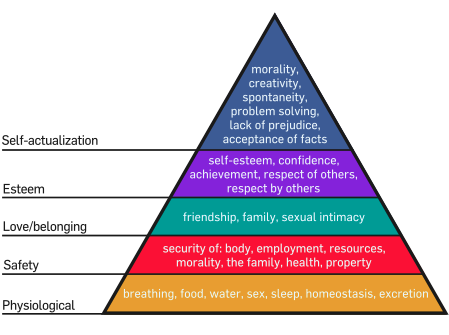 As I’ll be using the Maslow Hierarchy of Needs as part of my new project I wondered who this guy actually was. It turns out Abraham Maslow, from Brooklyn New York USA, was a psychologist who loved to question the status quo and find the brighter side of individuals looking holistically at all areas of life.
As I’ll be using the Maslow Hierarchy of Needs as part of my new project I wondered who this guy actually was. It turns out Abraham Maslow, from Brooklyn New York USA, was a psychologist who loved to question the status quo and find the brighter side of individuals looking holistically at all areas of life.
Here’s his bio on Wiki: https://en.wikipedia.org/wiki/Abraham_Maslow
The needs diagram so familiar to many of us (I’ve put a copy below) has the levels we go through to get a supreme state of being. He calls this level Self Actualization.

The bottom level is the most basic requirements of survival. (My son would include KFC there as well but I disagree.)
Once your basic needs are met, Safety is the next biggest need. This is why in my Stress Management course I point out that one of the biggest causes of professional burnout comes from employees feeling unsafe in their job. If there is any kind of threat that in a frenzied moment could lose them their job they will be on edge. Some managers think this is a good way to “keep people on their feet”, yet it has been proven many times over that an employee in this state of mind cannot make wise decisions, makes more mistakes, gets sick more often, is less enthusiastic about promoting the company = might be more tempted to pull a swift one and has little opportunity to open their intuition to allow in great new ideas and solutions that could benefit customers, staff and the organisation as a whole.
So! Safety is underestimated too often in the workplace. Make employees feel secure and valued, you’ll get better results from them.
Love and belonging follow this. On the journey of self development many are naturally tuned to isolating themselves from their families, friends and others in the community. Sometimes this is in order to go through their “days in the desert” as they were called in the bible. Other times they feel the need to cut off the old relationships they had in order to reconnect as the new person they become.
This is particularly important if their previous view of themselves was in fairly low esteem which encouraged others to treat them badly. If you go into your chrysalis, find yourself and emerge as the new confident you, you are more likely to get new behaviours from those around you rather than expecting them to bend slowly to match your speed of development which they won’t understand and find confusing. After all, it’s easier to know what to expect and just treat you the same as yesterday rather than checking in to see who you are today, noticing the changes and reacting accordingly.
The Esteem level I’ve included in the belonging level description. This very much applies to the workplace as well. Acknowledge achievement and offer respect no matter what disaster that person has caused. You will always get a better result in resolving problems when you approach the conversation with respect in mind.
Self actualisation level: To me, this is the ultimate goal of my project. When all the other levels are filled in for a group of people in a community, they relax, become happier, grow in confidence, stress levels drop, connect on a deeper level together so the sense of belonging is there (something the vast majority of my clients find are missing in their neighbourhoods) and the intuition opens up. Feeling safe and secure in that environment their gifts will be revealed.
Can you imagine a whole community of people who respect each other, care and offer a sense of belonging, appreciate diversity and encourage each other and feel the freedom to express their gifts? How many more inventions would come about? How quickly would problems be solved? How little crime would there be? How much healthier would they be?
It completely changes that community, their way of life and, even if their gifts are to simply make other people feel better, they feel confident and free to do so while appreciated in return.
What does a Self Actualised person look like?
I’ve copied this from the Wiki page:
He realized that all the individuals he studied had similar personality traits. All were “reality centered,” able to differentiate what was fraudulent from what was genuine. They were also “problem centered,” meaning that they treated life’s difficulties as problems that demanded solutions. These individuals also were comfortable being alone and had healthy personal relationships. They had only a few close friends and family rather than a large number of shallow relationships.
Self-actualizing people tend to focus on problems outside themselves; have a clear sense of what is true and what is false; are spontaneous and creative; and are not bound too strictly by social conventions.
Maslow noticed that self-actualized individuals had a better insight of reality, deeply accepted themselves, others and the world, and also had faced many problems and were known to be impulsive people. These self-actualized individuals were very independent and private when it came to their environment and culture, especially their very own individual development on “potentialities and inner resources”.
According to Maslow, self-actualizing people share the following qualities:
Truth: honest, reality, beauty, pure, clean and unadulterated completeness
Goodness: rightness, desirability, uprightness, benevolence, honesty
Beauty: rightness, form, aliveness, simplicity, richness, wholeness, perfection, completion,
Wholeness: unity, integration, tendency to oneness, interconnectedness, simplicity, organization, structure, order, not dissociated, synergy
Dichotomy: transcendence: acceptance, resolution, integration, polarities, opposites, contradictions
Aliveness: process, not-deadness, spontaneity, self-regulation, full-functioning
Unique: idiosyncrasy, individuality, non comparability, novelty
Perfection: nothing superfluous, nothing lacking, everything in its right place, just-rightness, suitability, justice
Necessity: inevitability: it must be just that way, not changed in any slightest way
Completion: ending, justice, fulfillment
Justice: fairness, suitability, disinterestedness, non partiality,
Order: lawfulness, rightness, perfectly arranged
Simplicity: nakedness, abstract, essential skeletal, bluntness
Richness: differentiation, complexity, intricacy, totality
Effortlessness: ease; lack of strain, striving, or difficulty
Playfulness: fun, joy, amusement
Self-sufficiency: autonomy, independence, self-determining.
Here’s an interview with Abraham Maslow which looks like it’s from the 60’s explaining why he wanted to cut a new pathway through the practice of psychology. Nice to see him talking. Footage is about 5 minutes.
I love his glass half full approach where he says
Human Nature is wise. Human Nature can pick for itself.
Each person can find their true Human Nature when they’re no longer in survival mode at the bottom level of the hierarchy.
Always remember this when you see someone being nasty, arrogant or rude. This is not their “true colours” at all. This is survival mode. Instead of being insulted, take a look at their situation and see what you can offer to make them feel safer.
And here below is an audio version of his book “The Theory of Human Motivation” originally published in “Psychological Review” in 1943. The description from the video
“Maslow describes humanity as a “wanting” species, and traces a chain of needs from the most basic (hunger), to the most self serving (personal safety, financial security), to the most social (esteem) and finally to the most transcendent (self-actualization). This conception of linking human growth to a final goal of living up to personal potential was a key development in later, more expansive psychological examinations of human happiness and self-fulfillment.”
Audio book is about an hour long.
Did you enjoy this article? The Kitegirl Coach blog is dedicated to collecting and considering information on the planetary and human evolution, Law of Attraction, the world shift in consciousness and creative careers. SHARE with like minded friends, FOLLOW on WordPress (button in the right column) for a regular feed or SUBSCRIBE for a monthly update on articles.